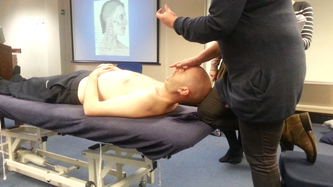This was very confusing at the beginning. We were told that there is not much dedicated research towards this department. The clear mechanisms behind these techniques have not been defined. All we know is that it works. I have seen this technique done before and have had it done, I am a believer who does believe that this works.
This mainly relies on trigger points, which have been annotated on diagrams in which I am still waiting for Miss Holmden to put on Bone. There are basic principles I had understood. If you are working on the posterior aspect, for example, cervical erectae spinae, the principle is to find a trigger point or a tender point and press down until about 3-4/10 pain. From here you extend, side bend and rotate away the head away. You add these levers until the pain is more or less gone. You hold in this position for 90 seconds. After 90 seconds you release and bring the head back to normal slowly!!
This seems to be the opposite for anterior structures, for example scalenes. Find a trigger point for the scalenes (over 1st or 2nd rib), unlike the posterior structures, this time you rotate, side bend and flex towards the applicator and hold for 90 seconds.
This can be done to various muscles over the body. We had learned psoas techniques, which can be done in many ways, as long as you apply the basic principles, in this case levers affecting anterior structure as you can access the psoas primarily from anteriorly.
What I believe you ask?
I believe the mechanisms behind strain counter-strain are that, you first find a hypertonic trigger point, which is contracted and has a constant barrage of neurological input. When you press down and you hold, you are constantly barraging stimulus and firing action potentials. After 7-10 seconds you have a refractory period where there is no firing of action potentials and therefore no contraction. In this constant cycle as the muscle stops contracting the trigger point unravels and muscles lengthen and relax.
I would like to thank Jo Holmden for teaching me these lovely techniques, especially psoas... which is awesome! :)
This mainly relies on trigger points, which have been annotated on diagrams in which I am still waiting for Miss Holmden to put on Bone. There are basic principles I had understood. If you are working on the posterior aspect, for example, cervical erectae spinae, the principle is to find a trigger point or a tender point and press down until about 3-4/10 pain. From here you extend, side bend and rotate away the head away. You add these levers until the pain is more or less gone. You hold in this position for 90 seconds. After 90 seconds you release and bring the head back to normal slowly!!
This seems to be the opposite for anterior structures, for example scalenes. Find a trigger point for the scalenes (over 1st or 2nd rib), unlike the posterior structures, this time you rotate, side bend and flex towards the applicator and hold for 90 seconds.
This can be done to various muscles over the body. We had learned psoas techniques, which can be done in many ways, as long as you apply the basic principles, in this case levers affecting anterior structure as you can access the psoas primarily from anteriorly.
What I believe you ask?
I believe the mechanisms behind strain counter-strain are that, you first find a hypertonic trigger point, which is contracted and has a constant barrage of neurological input. When you press down and you hold, you are constantly barraging stimulus and firing action potentials. After 7-10 seconds you have a refractory period where there is no firing of action potentials and therefore no contraction. In this constant cycle as the muscle stops contracting the trigger point unravels and muscles lengthen and relax.
I would like to thank Jo Holmden for teaching me these lovely techniques, especially psoas... which is awesome! :)




 RSS Feed
RSS Feed